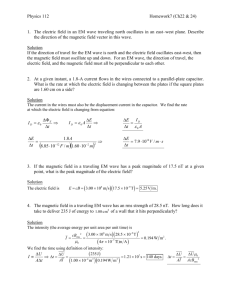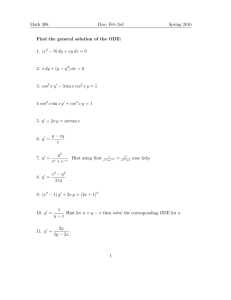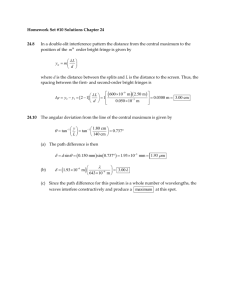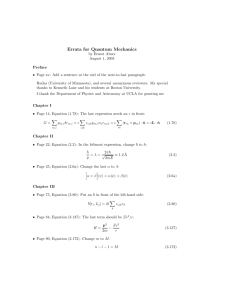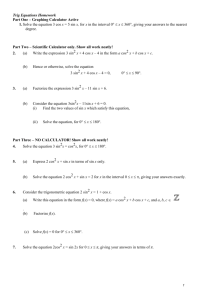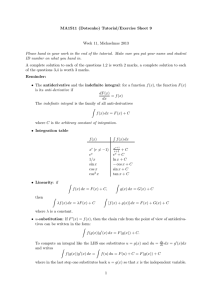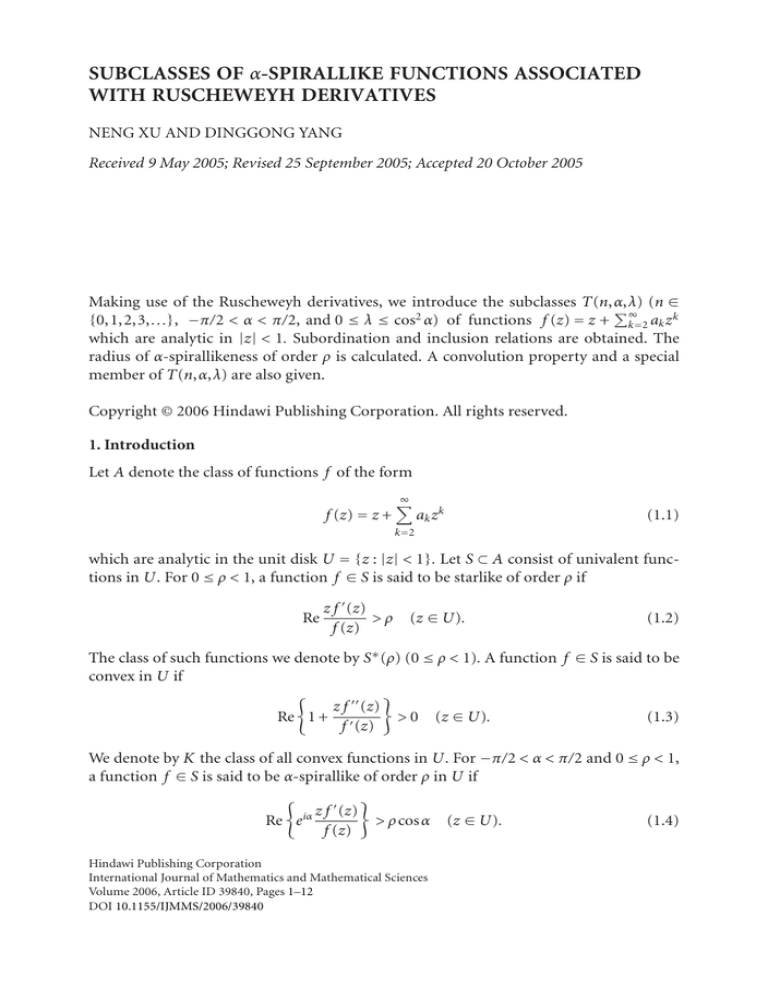
SUBCLASSES OF α-SPIRALLIKE FUNCTIONS ASSOCIATED
WITH RUSCHEWEYH DERIVATIVES
NENG XU AND DINGGONG YANG
Received 9 May 2005; Revised 25 September 2005; Accepted 20 October 2005
Making use of the Ruscheweyh derivatives, we introduce the subclasses T(n,α,λ)
(n ∈
∞
{0,1,2,3,...}, −π/2 < α < π/2, and 0 ≤ λ ≤ cos2 α) of functions f (z) = z + k=2 ak zk
which are analytic in |z| < 1. Subordination and inclusion relations are obtained. The
radius of α-spirallikeness of order ρ is calculated. A convolution property and a special
member of T(n,α,λ) are also given.
Copyright © 2006 Hindawi Publishing Corporation. All rights reserved.
1. Introduction
Let A denote the class of functions f of the form
f (z) = z +
∞
ak z k
(1.1)
k =2
which are analytic in the unit disk U = {z : |z| < 1}. Let S ⊂ A consist of univalent functions in U. For 0 ≤ ρ < 1, a function f ∈ S is said to be starlike of order ρ if
Re
z f (z)
>ρ
f (z)
(z ∈ U).
(1.2)
The class of such functions we denote by S∗ (ρ) (0 ≤ ρ < 1). A function f ∈ S is said to be
convex in U if
z f (z)
Re 1 + f (z)
> 0 (z ∈ U).
(1.3)
We denote by K the class of all convex functions in U. For −π/2 < α < π/2 and 0 ≤ ρ < 1,
a function f ∈ S is said to be α-spirallike of order ρ in U if
Re e
iα z f
(z)
f (z)
> ρ cosα
Hindawi Publishing Corporation
International Journal of Mathematics and Mathematical Sciences
Volume 2006, Article ID 39840, Pages 1–12
DOI 10.1155/IJMMS/2006/39840
(z ∈ U).
(1.4)
2
Subclasses of α-spirallike functions
Further let UCV ⊂ K be the class of functions introduced by Goodman [2] called uniformly convex in U. It was shown in [4, 7] that f ∈ A is in UCV if and only if
z f (z)
Re 1 + f (z)
z f (z) >
f (z) (z ∈ U).
(1.5)
In [7], Ronning investigated the class S p defined by
S p = f ∈ S∗ (0) : f (z) = zg (z), g ∈ UCV .
(1.6)
The uniformly convex and related functions have been studied by several authors (see,
e.g., [1–4, 7, 6, 8,12]).
∞
k
k
A, then the Hadamard product
If f (z) = z + ∞
k=2 ak z ∈ A and g(z) = z + k=2 bk z ∈
k
or convolution of f and g is defined by ( f ∗ g)(z) = z + ∞
k=2 ak bk z . Let
Dn f (z) =
z
∗ f (z),
(1 − z)n+1
(1.7)
for f ∈ A and n ∈ N0 = {0,1,2,3,...}. Then
z zn−1 f (z)
D f (z) =
n!
n
(n)
.
(1.8)
This symbol Dn f is called the Ruscheweyh derivative of order n of f . It was introduced
by Ruscheweyh [9].
In this paper we introduce and investigate the subclasses T(n,α,λ) of A as follows.
Definition 1.1. A function f ∈ A is said to be in T(n,α,λ) if
Re e
iα z
Dn f (z)
Dn f (z)
2
n
2
z D f (z) +λ > −
1
Dn f (z)
(z ∈ U),
(1.9)
where n ∈ N0 , −π/2 < α < π/2, and 0 ≤ λ ≤ cos2 α.
Note that, for λ = 0,
T(n,α,0) =
f ∈ A : Re e
iα z
Dn f (z)
Dn f (z)
z Dn f (z)
>
− 1 (z ∈ U) .
Dn f (z)
(1.10)
In particular, T(0,0,0) = S p and T(1,0,0) = UCV.
2. Properties of T(n,α,λ)
Let f and g be analytic in U. Then we say that f is subordinate to g in U, written f ≺ g,
if there exists an analytic function w in U such that |w(z)| ≤ |z| and f (z) = g(w(z)) for
z ∈ U. If g is univalent in U, then f ≺ g is equivalent to f (0) = g(0) and f (U) ⊂ g(U).
N. Xu and D. Yang 3
Theorem 2.1. Let n ∈ N0 ,α ∈ (−π/2,π/2), and λ ∈ [0,cos2 α]. A function f ∈ A belongs
to T(n,α,λ) if and only if
e
iα z
Dn f (z)
Dn f (z)
≺ h(z)cosα + isinα
(z ∈ U),
(2.1)
where
⎛
⎞2
1 + (z + β)/(1 + βz)
λ
2
⎠ ,
+ 2 ⎝log
h(z) = 1 −
2
2cos α π
1 − (z + β)/(1 + βz)
(2.2)
with
β=
eμ − 1
eμ + 1
2
√
μ=
,
λπ
.
2cosα
(2.3)
Proof. Let us define w = u + iv by
eiα
z Dn f (z)
Dn f (z)
= w(z)cosα + isinα
(z ∈ U).
(2.4)
Then w(0) = 1 and the inequality (1.9) can be rewritten as
1
λ
u > v2 + 1 −
.
2
cos2 α
(2.5)
Thus
w(U) ⊂ G = w = u + iv : u and v satisfy (2.5) .
(2.6)
It follows from (2.2) that
⎞2
⎛
1+ β
λ
2
⎠ = 1.
+ 2 ⎝log
h(0) = 1 −
2
2cos α π
1− β
(2.7)
In order to prove the theorem, it suffices to show that the function w = h(z) defined by
(2.2) maps U conformally onto the parabolic region G.
Note that
0≤
1
λ
λ
1−
< 1−
≤ 1,
2
2
cos α
2cos2 α
(2.8)
for 0 ≤ λ ≤ cos2 α. Consider the transformations
w1 =
w− 1−
λ
,
2cos2 α
w2 = e
√
2πw1
,
t=
1
1
w2 +
.
2
w2
(2.9)
4
Subclasses of α-spirallike functions
It is easy to verify that the composite function
λ
t = ϕ(w) = ch π 2w − 2 −
cos2 α
(2.10)
maps G+ = G {w = u + iv : v > 0} conformally onto the upper half plane Im(t) > 0 so
that w = (1/2)(1 − λ/ cos2 α) corresponds to t = −1 and w = 1 − λ/2cos2 α to t = 1. Applying the symmetry principle, the function t = ϕ(w) maps G conformally onto Ω = {t :
| arg(t + 1)| < π }. Since t = 2((1 + ζ)/(1 − ζ))2 − 1 maps the unit disk |ζ | < 1 onto Ω, we
see that
w = ϕ−1 (t) = 1 −
2
λ
1 2
log
t
+
t
−
1
+
2cos2 α 2π 2
⎞2
⎛
(2.11)
1+ ζ
λ
2
⎠ = g(ζ)
= 1−
+ ⎝log
2cos2 α π 2
1− ζ
maps |ζ | < 1 conformally onto G so that ζ = β (0 ≤ β < 1) corresponds to w = 1. Therefore the function
z+β
w = h(z) = g
1 + βz
(z ∈ U)
(2.12)
maps U conformally onto G and the proof of the theorem is complete.
Corollary 2.2. Let f ∈ T(n,α,λ), n ∈ N0 , α ∈ (−π/2,π/2), λ ∈ [0,cos2 α], and h be given
by (2.2). Then
Dn f (z)
≺ exp e−iα cosα
z
1
exp
0
Dn f (z)
h − ρ|z| − 1
dρ ≤ ρ
z
z
0
h(t) − 1
dt ,
t
eiα secα 1
h ρ|z| − 1
≤ exp
dρ ,
ρ
0
(2.13)
(2.14)
for z ∈ U. The bounds in (2.14) are sharp with the extremal function f0 ∈ A defined by
Dn f0 (z) = z exp e−iα cosα
z
0
h(t) − 1
dt .
t
(2.15)
Proof. From Theorem 2.1 we have
eiα z Dn f (z)
cosα
Dn f (z)
− 1 ≺ h(z) − 1,
(2.16)
N. Xu and D. Yang 5
for f ∈ T(n,α,λ). Since the function h − 1 is univalent and starlike (with respect to the
origin) in U, using (2.16) and the result of Suffridge [11, Theorem 3], we obtain
z Dn f (z)
eiα
eiα
=
log
cosα
z
cosα
Dn f (t)
1
−
dt ≺
Dn f (t)
t
0
z
0
h(t) − 1
dt.
t
(2.17)
This implies (2.13).
Noting that the univalent function h maps the disk |z| < ρ (0 < ρ ≤ 1) onto a region
which is convex and symmetric with respect to the real axis, we get
h − ρ|z| ≤ Reh(ρz) ≤ ρ|z|
(z ∈ U).
(2.18)
Now, (2.17) and (2.18) lead to
1 0
Dn f (z)
h − ρ|z| − 1
dρ ≤ log ρ
z
eiα secα 1 hρ|z|
− 1
≤
dρ,
ρ
0
(2.19)
for z ∈ U, which yields (2.14).
The bounds in (2.14) are best possible since the equalities are attained for the function
f0 in T(n,α,λ) defined by (2.15).
Theorem 2.3. Let f ∈ T(n,α,λ), n ∈ N0 , α ∈ (−π/2,π/2), λ ∈ [0,cos2 α]. Then Dn f is
α-spirallike of order ρ in |z| < r, where
2
2
β + tan (π/4) 2(1 − ρ) − λ/cos2 α
r = r(ρ,α,λ) =
1 + β tan (π/4) 2(1 − ρ) − λ/cos2 α
×
1
λ
λ
1−
≤ ρ < 1−
2
2
cos α
2cos2 α
(2.20)
and β is given by (2.2).The result is sharp.
Proof. It follows from (2.20) and (2.2) that
0 < 2(1 − ρ) −
λ
≤ 1,
cos2 α
0 ≤ β < r ≤ 1.
(2.21)
Let h be given by (2.2). Then
⎛
r − β 2
arctan
1 − βr
⎞2
1 + i (r − β)/(1 − βr)
2
λ
⎠
h(−r) = 1 −
+ 2 ⎝log
2
2cos α π
1 − i (r − β)/(1 − βr)
= 1−
λ
8
−
2cos2 α π 2
(2.22)
6
Subclasses of α-spirallike functions
and hence
inf Reh(z) = h(−r) = ρ.
(2.23)
|z|<r
If f ∈ T(n,α,λ), then from Theorem 2.1 and (2.23) we have
Re e
iα z
Dn f (z)
Dn f (z)
> ρ cos α
|z| < r ,
(2.24)
that is, Dn f is α-spirallike of order ρ in |z| < r. Further, the result is sharp with the extremal function f0 defined by (2.15).
Taking ρ = (1/2)(1 − λ/ cos2 α), Theorem 2.3 yields.
Corollary 2.4. Let f ∈ T(n,α,λ), n ∈ N0 , α ∈ (−π/2,π/2), λ ∈ [0,cos2 α]. Then Dn f is
α-spirallike of order (1/2)(1 − λ/ cos2 α) in U and the result is sharp.
Theorem 2.5. Let f ∈ T(n,α,λ), n ∈ N0 , α ∈ (−π/2,π/2), λ ∈ [0,cos2 α]. Then Dn f ∈
S∗ ((1 − λ)/2) and the order (1 − λ)/2 is sharp.
Proof. Let h be given by (2.2). Then it follows from the proof of Theorem 2.1 that
∂h(U) = w = u + iv : u =
1 2
λ
v +1−
2
cos2 α
.
(2.25)
g(u)cosα + sin2 α,
(2.26)
Hence
min Re e−iα h(z)cosα + isinα
=
|z|=1(z
=1)
min
u≥(1/2)(1−λ/cos2 α)
where
g(u) = ucosα − | sinα| 2u − 1 +
λ
cos2 α
u≥
1
λ
1−
2
cos2 α
.
(2.27)
Since
g (u) = cosα − √
| sinα|
2u − 1 + λ/cos2 α
u>
1
λ
1−
2
cos2 α
,
(2.28)
the function g attains its minimum value at u = (1 − λ)/2cos2 α. Thus
min Re e−iα h(z)cosα + isinα
|z|=1(z
=1)
=g
1−λ
1−λ
cosα + sin2 α =
.
2cos2 α
2
(2.29)
Let f ∈ T(n,α,λ). Then, by Theorem 2.1 and (2.29), we conclude that Dn f is starlike
of order (1 − λ)/2 in U, and the function f0 defined by (2.15) shows that the order (1 −
λ)/2 is sharp.
Theorem 2.6. T(n + 1,α,λ) ⊂ T(n,α,λ), where n ∈ N0 , α ∈ (−π/2,π/2), λ ∈ [0,cos2 α].
N. Xu and D. Yang 7
Proof. It follows from (1.7) that
z Dn f (z) = (n + 1)Dn+1 f (z) − nDn f (z) (z ∈ U),
(2.30)
for f ∈ A. Set
z Dn f (z)
Dn f (z)
p(z) = eiα
(z ∈ U).
(2.31)
Then (2.30) and (2.31) lead to
Dn+1 f (z) e−iα p(z) + n
=
Dn f (z)
n+1
(z ∈ U).
(2.32)
Differentiating both sides of (2.32) logarithmically and using (2.31), we get
e
iα z
Dn+1 f (z)
Dn+1 f (z)
= p(z) +
zp (z)
e−iα p(z) + n
(z ∈ U).
(2.33)
If f ∈ T(n + 1,α,λ), then by Theorem 2.1 and (2.33) we have
p(z) +
zp (z)
e−iα p(z) + n
≺ h(z)cosα + isinα
(z ∈ U),
(2.34)
where h is given by (2.2). The function Q(z) = e−iα (h(z)cosα + isinα) + n is univalent
and convex in U and
1−λ
+ n ≥ 0 (z ∈ U)
2
ReQ(z) >
(2.35)
because of (2.29). Hence an application of the result of Miller and Mocanu [5, Corollary
1.1] yields
p(z) = e
iα z
Dn f (z)
Dn f (z)
≺ h(z)cosα + isinα
(z ∈ U).
Now, by Theorem 2.1, we know that f ∈ T(n,α,λ) and the theorem is proved.
(2.36)
Remark 2.7. Combining Theorem 2.6 with Corollary 2.4, we see that each function in
T(n,α,λ) is α-spirallike of order (1/2)(1 − λ/ cos2 α) in U. In view of Theorems 2.5 and
2.6 we have T(n,α,λ) ⊂ S∗ ((1 − λ)/2).
Theorem 2.8. A function f ∈ A is in T(n,α,λ) if and only if
F(z) =
n+1
zn
z
0
t n−1 f (t)dt
is in T(n + 1,α,λ), where n ∈ N0 , α ∈ (−π/2,π/2), λ ∈ [0,cos2 α].
(2.37)
8
Subclasses of α-spirallike functions
Proof. It follows from (2.37) that F ∈ A and
(n + 1) f (z) = nF(z) + zF (z) (z ∈ U),
(2.38)
for f ∈ A. By using (2.30) and (2.38), we obtain
nDn F(z) + z Dn F(z)
D f (z) =
n+1
n
= Dn+1 F(z)
(z ∈ U),
(2.39)
which proves the assertions of the theorem.
Let R(ρ) be the class of prestarlike functions of order ρ in U consisting of functions
f ∈ A satisfying
z
∗ f (z) ∈ S∗ (ρ),
(1 − z)2−2ρ
(2.40)
for some ρ (0 ≤ ρ < 1). The following lemma is due to Ruscheweyh [10].
Lemma 2.9. If f ∈ S∗ (ρ) and g ∈ R(ρ) (0 ≤ ρ < 1), then for any analytic function F in U,
g ∗ (F f )
(U) ⊂ co F(U) ,
g∗ f
(2.41)
where co(F(U)) stands for the convex hull of F(U).
Applying the lemma, we derive the following.
Theorem 2.10. Let f ∈ T(n,α,λ) and g ∈ R((1 − λ)/2). Then
f ∗ g ∈ T(n,α,λ),
(2.42)
where n ∈ N0 , α ∈ (−π/2,π/2), λ ∈ [0,cos2 α].
Proof. Let f ∈ T(n,α,λ). Making use of Theorems 2.1 and 2.5, we have
F(z) =
z(Dn f (z))
≺ e−iα (h(z)cosα + isinα),
Dn f (z)
D n f ∈ S∗
1−λ
.
2
(2.43)
If we put ϕ = f ∗ g, then for z ∈ U,
z(Dn ϕ(z)) z(g(z) ∗ Dn f (z)) g(z) ∗ (z(Dn f (z)) )
=
=
Dn ϕ(z)
g(z) ∗ Dn f (z)
g(z) ∗ Dn f (z)
g(z) ∗ (F(z)Dn f (z))
=
.
g(z) ∗ Dn f (z)
(2.44)
N. Xu and D. Yang 9
Since the univalent function e−iα (h(z)cosα + isinα) is convex in U and g ∈ R((1 − λ)/2),
from (2.43), (2.44), and the lemma we deduce that
z Dn ϕ(z)
Dn ϕ(z)
≺ e−iα (h(z)cosα + isinα).
(2.45)
Therefore, by using Theorem 2.1, ϕ ∈ T(n,α,λ) and the proof is complete.
Note that R(1/2) = S∗ (1/2). Since R(ρ1 ) ⊂ R(ρ2 ) for 0 ≤ ρ1 < ρ2 < 1 (see [10]), we have
K = R(0) ⊂ R((1 − λ)/2). Thus Theorem 2.10 yields the following.
Corollary 2.11. (i) If f ∈ T(n,α,0), n ∈ N0 , α ∈ (−π/2,π/2), and g ∈ S∗ (1/2), then
f ∗ g ∈ T(n,α,0).
(ii) If f ∈ T(n,α,λ), n ∈ N0 , α ∈ (−π/2,π/2), λ ∈ [0,cos2 α], and g ∈ K, then f ∗ g ∈
T(n,α,λ).
Theorem 2.12. Let n ∈ N0 , α ∈ (−π/2,π/2), λ ∈ [0,cos2 α]. The function f ∈ A defined
by
Dn f (z) =
z
(1 − bz)2e−iα cosα
(z ∈ U)
(2.46)
is in T(n,α,λ), where b is complex and
⎧
cos2 α + λ
⎪
⎪
⎪
⎪
⎨ 3cos2 α − λ
|b| = √
⎪
⎪
λ
⎪
⎪
⎩
√
√ √ 0 ≤ λ ≤ 3 − 2 2 cos2 α ,
2cosα + λ
3−2 2
cos2 α ≤ λ ≤ cos2 α
(2.47)
.
The result is sharp, that is, |b| cannot be increased.
Proof. Let f ∈ A be given by (2.46). Then
eiα
z(Dn f (z)) 1 + bz
=
cosα + isinα.
Dn f (z)
1 − bz
(2.48)
Hence, by Theorem 2.1, f ∈ T(n,α,λ) if and only if
1 + bz
≺ h(z),
1 − bz
(2.49)
where h is given by (2.2), or, equivalently, when
2|b|
1 + |b|2 ⊂ h(U),
w:
w
−
<
1 − |b|2 1 − |b|2
for 0 < |b| < 1.
(2.50)
10
Subclasses of α-spirallike functions
Let δ denote the minimum distance from the point (1 + |b|2 )/(1 − |b|2 ) to the points
on the parabola ∂h(U) given by (2.25). Then
δ=
min
u≥(1/2)(1−λ/cos2 α)
1 + |b|2
g(u) = u −
1 − |b|2
g(u),
2
+ 2u − 1 +
λ
.
cos2 α
(2.51)
Note that
1 + |b|2 1
λ
>
1−
,
1 − |b|2 2
cos2 α
2|b|2
g (u) = 2 u −
.
1 − |b|2
(2.52)
(i) If
√
0 ≤ λ ≤ (3 − 2 2)cos2 α,
|b| =
cos2 α + λ
,
3cos2 α − λ
(2.53)
then λ2 − 6λ cos2 α + cos4 α ≥ 0. Thus
|b|2 =
cos2 α + λ
3cos2 α − λ
2
≤
cos2 α − λ
,
5cos2 α − λ
1
λ
2|b|2
≤
1−
.
1 − |b|2 2
cos2 α
(2.54)
From (2.51), (2.52) and (2.54), we have g (u) ≥ 0 and hence
1
1−
δ = g
λ
cos2 α
2
1 + |b|2 1
λ
2|b|
−
1−
.
=
=
1 − |b|2 2
cos2 α
1 − |b|2
(2.55)
√
(ii) If 0 ≤ λ < (3 − 2 2)cos2 α and
cos2 α + λ
< |b| <
3cos2 α − λ
cos2 α − λ
,
5cos2 α − λ
(2.56)
then g (u) > 0 and
2|b|
1 + |b|2 1
λ
δ=
−
1−
<
.
1 − |b|2 2
cos2 α
1 − |b|2
(2.57)
(iii) If
√
2
2
(3 − 2 2)cos α ≤ λ ≤ cos α,
|b| =
√
λ
√ ,
2cosα + λ
(2.58)
N. Xu and D. Yang
11
then λ2 − 6λ cos2 α + cos4 α ≤ 0 and so
√
2
|b| =
λ
cos2 α − λ
√ ≥
,
2cosα + λ 5cos2 α − λ
1
λ
2|b|2
≥
1−
.
2
1 − |b|
2
cos2 α
(2.59)
Thus we have
δ=
2|b|2
g
=
1 − |b|2
√
λ
4|b|2
2|b|
+
=
.
2
2
1 − |b|
cos α 1 − |b|2
(iv) If (3 − 2 2)cos2 α ≤ λ ≤ cos2 α and
δ=
√
(2.60)
√
λ/(2cosα + λ) < |b| < 1, then
λ
4|b|2
2|b|
+
.
<
1 − |b|2 cos2 α 1 − |b|2
(2.61)
By virtue of (2.49), (2.50), (2.55), (2.57), (2.60), and (2.61), the proof of the
theorem is now complete.
Letting n = α = 0 in Theorem 2.12, we have the following.
Corollary 2.13. The function f (z) = z/(1 − bz)2 is in T(0,0,λ), where λ ∈ [0,1],b is
complex and
⎧
1+λ
⎪
⎪
⎪
⎪
⎨3−λ
|b| = √
⎪
⎪
λ
⎪
⎪
⎩
√
2+ λ
√ 0 ≤ λ ≤ 3−2 2 ,
√
(2.62)
3−2 2 ≤ λ ≤ 1 .
The result is sharp, that is, |b| cannot be increased.
References
[1] K. K. Dixit and I. B. Misra, A class of uniformly convex functions of order α with negative and
fixed finitely many coefficients, Indian Journal of Pure and Applied Mathematics 32 (2001), no. 5,
711–716.
[2] A. W. Goodman, On uniformly convex functions, Annales Polonici Mathematici 56 (1991), no. 1,
87–92.
, On uniformly starlike functions, Journal of Mathematical Analysis and Applications 155
[3]
(1991), no. 2, 364–370.
[4] W. C. Ma and D. Minda, Uniformly convex functions, Annales Polonici Mathematici 57 (1992),
no. 2, 165–175.
[5] S. S. Miller and P. T. Mocanu, On some classes of first-order differential subordinations, The Michigan Mathematical Journal 32 (1985), no. 2, 185–195.
[6] F. Rønning, A survey on uniformly convex and uniformly starlike functions, Annales Universitatis
Mariae Curie-Skłodowska. Sectio A. Mathematica 47 (1993), 123–134.
, Uniformly convex functions and a corresponding class of starlike functions, Proceedings
[7]
of the American Mathematical Society 118 (1993), no. 1, 189–196.
, On uniform starlikeness and related properties of univalent functions, Complex Variables.
[8]
Theory and Application 24 (1994), no. 3-4, 233–239.
12
Subclasses of α-spirallike functions
[9] S. Ruscheweyh, New criteria for univalent functions, Proceedings of the American Mathematical
Society 49 (1975), 109–115.
, Convolutions in Geometric Function Theory, Seminar on Higher Mathematics, vol. 83,
[10]
Presses de l’Université de Montréal, Quebec, 1982.
[11] T. J. Suffridge, Some remarks on convex maps of the unit disk, Duke Mathematical Journal 37
(1970), no. 4, 775–777.
[12] D. Yang and S. Owa, Properties of certain p-valently convex functions, International Journal of
Mathematics and Mathematical Sciences 2003 (2003), no. 41, 2603–2608.
Neng Xu: Department of Mathematics, Changshu Institute of Technology,
Changshu, Jiangsu 215500, China
E-mail address: xuneng11@pub.sz.jsinfo.net
Dinggong Yang: Department of Mathematics, Suzhou University, Suzhou, Jiangsu 215006, China


